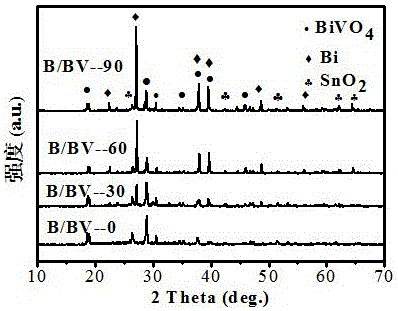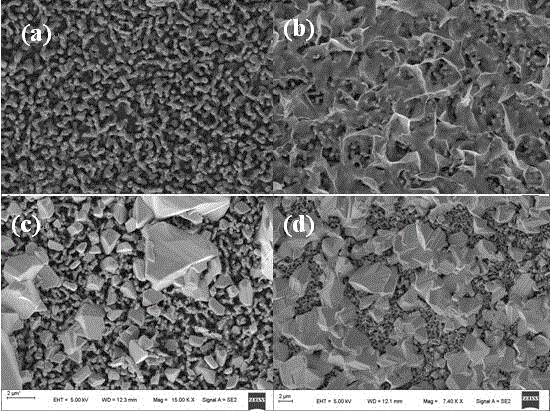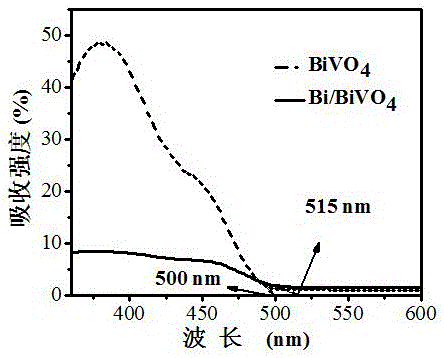Method for preparing Bi/BiVO4 composite photoanode material by photodeposition
A photoanode and photodeposition technology, which is applied in the direction of electrodes, metal material coating technology, electrolysis process, etc., can solve the problems of unstable chemical properties, weak absorption capacity, and low conversion efficiency of incident photons
- Summary
- Abstract
- Description
- Claims
- Application Information
AI Technical Summary
Problems solved by technology
Method used
Image
Examples
Embodiment 1
[0037] (1) BiVO 4 Preparation of photoanode: According to the method of electrodeposition combined with heat treatment by Kim and Choi's group, porous BiVO 4 The membrane was successfully prepared. Steps: First, BiOI nanosheets were prepared by electrodeposition using CHI 660D electrochemical workstation. FTO glass cleaned ultrasonically with acetone / isopropanol / distilled water (volume ratio: 1:1:1) was used as the working electrode, the Ag / AgCl (3.5 M KCl) electrode was used as the reference electrode, and the Pt electrode was used as the counter electrode. with 6M HNO 3 Adjust the pH of 50 mL0.4 M KI solution to 1.5~1.7, then add 0.970 g Bi(NO 3 ) 3 ·5H 2 O until dissolved and the solution color changed to orange-red. Then slowly add 20ml 0.498 g 1,4-benzoquinone ethanol solution dropwise and stir for several minutes, the solution turns blood red again. Electrodeposition was scanned by cyclic voltammetry, voltage: -0.13-0 V, scan rate: 5 mV / s. The obtained BiOI film ...
Embodiment 2
[0040] (1) BiVO 4 The preparation of photoanode: with embodiment 1;
[0041] (2) Bi / BiVO 4 Preparation of composite photoanode: the BiVO 4 The electrode was soaked in 20 mL 0.01 M Bi(NO 3 ) 3 ·5H 2 O in ethylene glycol / water (V%=1) solution, irradiated with 300 W xenon lamp for 60 min to make BiVO 4 A layer of gray-black film was evenly grown on the film; it was washed completely with ethanol to obtain Bi / BiVO 4 Composite photoanode, labeled Bi / BV-60. When U=1.3V, I=9.48mA / cm 2 .
Embodiment 3
[0043] (1) BiVO 4 The preparation of photoanode: with embodiment 1;
[0044] (2) Bi / BiVO 4 Preparation of composite photoanode: the BiVO 4 The electrode was soaked in 20 mL 0.01 M Bi(NO 3 ) 3 ·5H 2 O in ethylene glycol / water (V%=1) solution, irradiated with 300 W xenon lamp for 90 min to make BiVO 4 A layer of gray-black film was evenly grown on the film; it was washed completely with ethanol to obtain Bi / BiVO 4Composite photoanode, labeled Bi / BV-90. When U=1.3V, I=8.4mA / cm 2 .
PUM
| Property | Measurement | Unit |
|---|---|---|
| volume ratio | aaaaa | aaaaa |
Abstract
Description
Claims
Application Information
 Login to View More
Login to View More - R&D
- Intellectual Property
- Life Sciences
- Materials
- Tech Scout
- Unparalleled Data Quality
- Higher Quality Content
- 60% Fewer Hallucinations
Browse by: Latest US Patents, China's latest patents, Technical Efficacy Thesaurus, Application Domain, Technology Topic, Popular Technical Reports.
© 2025 PatSnap. All rights reserved.Legal|Privacy policy|Modern Slavery Act Transparency Statement|Sitemap|About US| Contact US: help@patsnap.com



